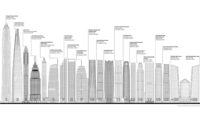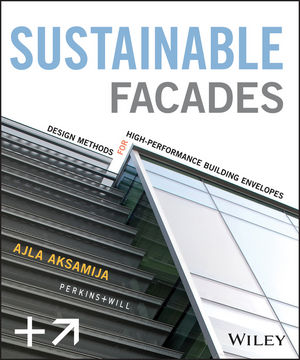Skyscrapers have figured dramatically in Chicago's architectural reputation'and will play a big part in the city's future.
Everyone knows that Chicago is the birthplace of the skyscraper.
And it is true—depending on how you define the building type. As Carol Willis points out in Form Follows Finance: Skyscrapers and Skylines in New York and Chicago, if you go by the technological innovations of the elevator and the metal frame, then Chicago was first, but if height matters most, it was New York. Chicago produced the first metal-frame structure, crucial to the development of the tall tower: the Home Insurance Building, designed by William LeBaron Jenney in 1884. Its cast-iron columns with wrought-iron beams, plus newly developed rolled-steel beams, made history. Then the first all-steel-frame skyscraper—Burnham and Root’s second Rand McNally Building—debuted in 1890, called by many the first true skyscraper because of that all-steel frame. These “skyscraping” structures with their “skyscraperly” tactics—as The Chicago Daily Tribune characterized them in 1884, essentially coining the term—were made possible by such frames, along with the invention of the elevator.
But these buildings only reached 130 feet for Home Insurance (with a later expansion to 180 feet) and 120 feet for Rand McNally. New York already had taller buildings: the 230-foot-foot-high Western Union Telegraph Building, designed by George Post (1875), and the 260-foot-high Tribune Building, by Richard Morris Hunt (1876), which towered over lower Manhattan.
Yet, since New York’s were hybrid, mostly bearing-wall construction, Chicago’s technical achievements promised even greater heights. But two problems held back the otherwise adventurous plainsmen: mushy soil (as opposed to Manhattan’s rocky schist) and an 1893 city ordinance that imposed a height limit of 130 feet. Before the limit was imposed, however, Burnham & Root’s steel-framed Masonic Temple building, completed in 1892, held the tallest-in-the-world title at 302 feet. (The firm’s solidly massed Monadnock Building, of the same year, was said to be the tallest commercial structure in the world that had load-bearing masonry walls, topping off at 215 feet.)
New York began making these records look paltry with a cluster of ever-taller buildings, including Ernest Flagg’s 612- foot-high Singer Tower in 1908 and Cass Gilbert’s 792-foot-high Woolworth Building in 1913. Even though Louis Sullivan had theorized about the design for this new type in his essay “The Tall Office Building Artistically Considered” of 1896, his own application of his form-follows-function dictum came out short: New York’s Bayard-Condict Building (1897) was only 13 stories.
Chicago lifted its height limits in 1920, allowing the 425-foot-tall Wrigley Building, designed by Graham, Anderson, Probst & White (1921) to anchor downtown, across Michigan Avenue from the 462-foot Tribune Tower by the New York firm of Howells & Hood (1925). But those were soon left behind by the Chrysler Building (1930), by William Van Alen, at 1,050 feet, and the Empire State Building (1931), by Shreve, Lamb & Harmon, which, at 1,250 feet, held the title for decades as the world’s tallest skyscraper.
Not surprisingly, the race for even taller buildings slowed during the Depression, but Chicago came alive after World War II. Ludwig Mies van der Rohe had arrived from Germany in 1938, and, while height didn’t seem part of his agenda, his refinements to the Chicago frame and its application to residential construction at 860-880 Lake Shore Drive (1951) and 900-910 North Lake Shore Drive (1955) refocused attention on the city as a capital of innovative high-rise design. With the growth of Skidmore, Owings & Merrill (SOM) and a cohort of Mies-minded architects, the Second Chicago School was launched.
There was one significant exception to the prevalence of the Chicago steel frame: Bertrand Goldberg’s radical Marina City (1964), with its two 587-foot-high cylinders and curvilinear balconies, was the tallest reinforced-concrete structure in the world at that time. In 1970, SOM’s steel-frame Hancock Tower climbed to 1,095 feet; then, in 1974, the firm’s steel-frame Sears Tower, (now Willis) became, at 1,450 feet, the tallest building in the world, grabbing the title from the World Trade Center’s Twin Towers. Chicago was at its pinnacle in advancing the skyscraper.
Now the height obsession is being played out globally, with Chicago architects leading the way. The Burj Khalifa in Dubai, currently the world’s tallest at 2,722 feet, was designed by Adrian Smith of the Chicago office of SOM. When he left to start his own firm, Adrian Smith + Gordon Gill Architecture, he was commissioned to design Kingdom Tower in Jedda, which will surpass the Burj for the top title at 3,280 feet when it opens in 2017. On the home turf, Smith, as design partner of SOM, only ascended to 1,116 feet with his Trump International Hotel.
Meanwhile, the Willis Tower lost its status as America’s tallest skyscraper two years ago, after a nasty skirmish with New York, when the Council on Tall Buildings ruled that One World Trade Center could count its spire as part of its 1,776-foot height. “Chicago seems to be in a midlife crisis,” says Alexander Eisenschmidt, coeditor of Chicagoisms: The City as Catalyst for Architectural Speculation. “Chicago is in a more reflective age.”
Yet a new generation of Chicago architects is rising to design skyscrapers for their hometown that emphasize sensuous form along with accomplished technique. Just look at the poured-concrete curves of the 82-story, 859-foot-high Aqua apartments by Studio Gang (2010) or the firm’s scheme for the slightly billowing, slender, strandlike shafts of the 1,100-foot-high Wanda Vista, to be completed by 2019. Other Chicago architects are creating supple, shimmering glass towers with frames almost undetectable to the eye: Krueck + Sexton just won approval for a 752-foot-high skyscraper at 130 North Franklin Street; John Ronan Architects is designing a 36-story high-rise nearby, which appears in seductive renderings as evanescent, also almost invisible.
So is Chicago morally superior—or do economic and political forces make it less concerned with height today than Manhattan is? Maybe Chicago’s approach to innovative form and technique will prove that height isn’t everything. It’s up to the third Chicago school to show us.
|
|
|
Panorama of a Phantom Chicago, 2012 © Alexander Eisenschmidt / Visionary Cities Project. |














